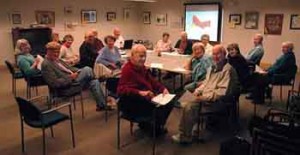The Melrose Mirror | Melrose, Mass.
Created in 1996 with the assistance of the MIT Media Lab.
Rye Reflections | Rye, N.H.
Launched in 2005 under the direction of Jack Driscoll, editor-in-residence of the MIT Media Lab.
The Idea
Web-based publishing was in its infancy, and the term citizen journalism had yet to be coined when the MIT Media Lab and a group of volunteers at the Milano Senior Center in Melrose, Mass., launched a monthly online publication in 1996 that still serves as a model for citizen-driven reporting.

Members of the SilverStringers project in Melrose, Mass., offer lessons from their citizen journalism experience to the staff of the newly launched Rye Reflections in April 2005.
Dubbed the SilverStringers, the seniors in Massachusetts began publishing the monthly Melrose Mirror after a series of journalism lessons from former Boston Globe editor Jack Driscoll, now editor-in-residence at the Media Lab, and computer lessons from MIT students. Driscoll said he saw the kind of grassroots journalism of the SilverStringers project as “the wave of the future for journalism – not being the answer, but part of what was coming.”
The Melrose Mirror served as a model for a web-based, international student publication, The Junior Journal, which published from 1998 to 2005, and the launch in 2005 of Rye Reflections, a monthly online news site produced by citizens in the 5,000-population town of Rye, N.H.
The Training
Beginning with 15 people at the Milano Senior Center in 1996, Driscoll led classroom sessions every two weeks that alternated between journalism workshops and technology training. He continues to meet with the group monthly and critiques the publication.
Using the same journalism tutorials developed for the SilverStringers project, Driscoll held weekly workshops in 2005 to help launch Rye Reflections.
Journalism workshops discuss how to develop story ideas, how to conduct interviews, writing techniques, and tips on photography and editing. Driscoll said he emphasizes accuracy, revision, and the importance of over-reporting. “You can teach writing until you’re blue in the face,” he said. “There are so many aspects to writing that can be learned.”
The group dynamic also stimulates reporting lessons that Driscoll says would not happen if participants were writing individual blogs. When one person wanted to write a story about a pond in Melrose, for instance, other participants suggested reporting tips that ranged from talking to workers with the Army Corps of Engineers to employees of the ice company that once cut blocks of ice from the pond.
Online curriculum and tutorials are available here.
The Recruits
Some 80 to 100 seniors have participated in the SilverStringers project over the last 10 years, with about 15 to 18 people making up the core group of reporters and editors each month.
In Rye, about 17 citizen journalists are identified on the news site as contributors, and Driscoll said about six others are writing freelance pieces for the site but do not regularly attend the group’s weekly meetings, held at the local library.
In both projects, few participants had any previous writing or reporting experience. The citizen journalists in Rye include a former flight attendant, a retired auto dealer, a school principal and community activists.
The Results
Drawing on the life experiences of its citizen reporters, the Melrose Mirror has published packages on World War II and the Great Depression. One early participant, the late Bill Jodrey, wrote a piece about living as a railroad hobo that later grew into a 26-chapter book, “Tales of the Open Road,” that the SilverStringers self published.
In Rye, the site has sought to be more news-oriented. Because covering breaking news with volunteers is difficult, the site as “tried to latch on to working stories,” such as the long-delayed construction of a new police and fire building.
“I think people felt as though there were a lot of good stories to be told in this small seacoast community that couldn’t be told in the local newspaper,” Driscoll said. “But we don’t see ourselves competing with them. To some degree, we’re supplementing them.”
